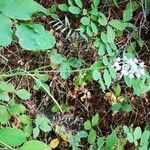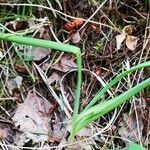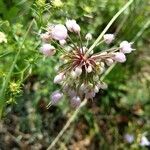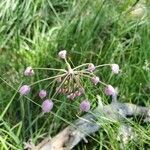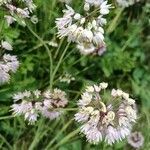Bulbs 2–5+, clustered, often short-rhizomatous at base, rhizome not stout or iris-like, oblong, elongate, 1–3 × 0.8–1.5 cm; outer coats enclosing 1 or more bulbs, grayish or brownish, membranous, minutely striate, cells in regular vertical rows, narrowly elongate, fibers persistent, parallel, few; inner coats white to pink or reddish, cells in regular vertical rows, narrowly elongate. Leaves persistent, green at anthesis, 3–5, basally sheathing, sheaths not extending much above soil level; blade solid, flat, channeled to broadly V-shaped in cross section, 10–25 cm × 1–6 mm, margins entire or denticulate. Scape persistent, sometimes 2 or more produced successively from single bulb, usually clustered, nodding, solid, terete or ridged, particularly distally, sometimes flattened and narrowly winged, abruptly recurved near apex, 10–50 cm × 1–3 mm. Umbel persistent, cernuous, loose, 8–35-flowered, hemispheric, bulbils unknown; spathe bracts persistent, 2, 3-veined, lanceolate, ± equal, apex acuminate, beakless. Flowers campanulate, 4–6 mm; tepals ± erect, pink or white, elliptic-ovate, ± equal, withering in fruit, margins ± entire, apex ± obtuse, at least outer tepals strongly incurved, midribs not thickened; stamens exserted; anthers yellow; pollen yellow; ovary conspicuously crested; processes 6, flattened, ± triangular, margins entire or toothed; style exserted, linear, ± equaling stamens; stigma capitate, scarcely thickened, unlobed; pedicel 6–25 mm, becoming stouter in fruit, elongating and bending abruptly upward from near point of attachment. Seed coat dull or shining; cells smooth, minutely roughened, or each with minute, central papilla. 2n = 14.
More
Bulb slenderly conic, very gradually tapering into the stem; lvs several, arising near together at the soil-surface, shorter than the stem, 2–4(–8) mm wide; scape 3–6 dm, abruptly declined near the top; umbel nodding (at least in bud), many-fld, without bulblets; pedicels 12–25 mm, becoming rigid; tep white to rose, ovate or elliptic, 4–6 mm, obtuse or subacute; stamens exsert; filaments barely widened at base; fr obovoid, 3-lobed, 4 mm, each valve (and each lobe of the ovary) bearing 2 erect triangular processes near the top; 2n=14. Dry woods, rocky banks, and prairies; N.Y. to Mich., Minn., and B.C., s. to Va., Ky., and Mo., and in the mts. to Ga., Ala., and Ariz. July, Aug. (A. allegheniense; A. oxyphilum Wherry, of shale-barrens, with few, whitish fls, may merit some recognition)
An onion family bulb plant. It grows to 45 cm high and is 25 cm wide. The bulb is about 50 mm tall and 15 mm wide. The bulbs are grouped on a short rhizome. There are up to 6 leaves per bulb and they are flattened. They are 40 cm long. The flowering stems carry a drooping head of flowers. There are 20-30 pale pink or red, cup-shaped flowers. The flower heads straighten when seeds form.
